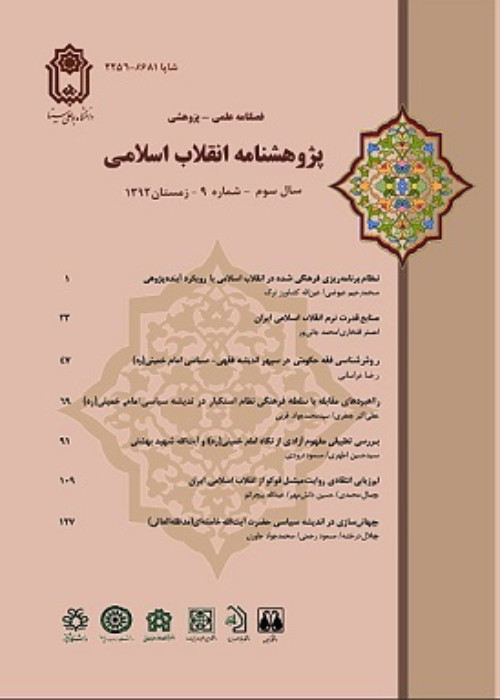Comparative Analysis of Construction Performance in the Process of the Islamic Revolution of Iran (1979) and the Egyptian Revolution (2011)
Author(s):
Article Type:
Research/Original Article (دارای رتبه معتبر)
Abstract:
As part of international relations, revolutions have always been one of the foundations for comparative politics. Among the major revolutions in human history, the Islamic Revolution of Iran in 1979 had an enormous impact on political studies because dimensions, nature, The process and its components also differed from the material revolutions before them. This revolution has the indicators and components that have led to its continuity and, on the contrary, many revolutionary events in the Muslim world have led to a decline in the course of the failure of these components. The January 25, 2011 revolution in Egypt was also one of the new revolutions in the process of Islamic awakening, which, despite the victory, was challenged by a military coup. For this reason, the present article seeks to examine the performance of the two Iranian-Egyptian revolutions. To this end, using the method of comparative analysis and descriptive studies, it is attempted to answer this question; what are the differences between the performance of construction in the process of the Islamic Revolution (1979) and the Egyptian revolution (2011)? In order to explain this, we use the Giddens structural construct-oriented framework and the structure-agent function and analyze the data using SPSS software. Some findings show that the Iranian-Egyptian revolution in such indices as leadership, strength of power, political independence, Islamism, military loyalty, favorable changes, solidarity between government and nation, communication networks, youth activism, authoritarianism, efficiency Transcendental values, national identity, economic dependence, religious divide, sustainable development, anxiety and inspiration are different.In order to explain this, we use the Giddens structural construct-oriented framework and the structure-agent function and analyze the data using SPSS software. Some findings show that the Iranian-Egyptian revolution in such indices as leadership, strength of power, political independence, Islamism, military loyalty, favorable changes, solidarity between government and nation, communication networks, youth activism, authoritarianism, efficiency Transcendental values, national identity, economic dependence, religious divide, sustainable development, anxiety and inspiration are different.
Keywords:
Language:
Persian
Published:
Scientific Research Journal on Islamic Revolution, Volume:7 Issue: 26, 2018
Pages:
151 to 176
magiran.com/p1861094
دانلود و مطالعه متن این مقاله با یکی از روشهای زیر امکان پذیر است:
اشتراک شخصی
با عضویت و پرداخت آنلاین حق اشتراک یکساله به مبلغ 1,390,000ريال میتوانید 70 عنوان مطلب دانلود کنید!
اشتراک سازمانی
به کتابخانه دانشگاه یا محل کار خود پیشنهاد کنید تا اشتراک سازمانی این پایگاه را برای دسترسی نامحدود همه کاربران به متن مطالب تهیه نمایند!
توجه!
- حق عضویت دریافتی صرف حمایت از نشریات عضو و نگهداری، تکمیل و توسعه مگیران میشود.
- پرداخت حق اشتراک و دانلود مقالات اجازه بازنشر آن در سایر رسانههای چاپی و دیجیتال را به کاربر نمیدهد.
In order to view content subscription is required
Personal subscription
Subscribe magiran.com for 70 € euros via PayPal and download 70 articles during a year.
Organization subscription
Please contact us to subscribe your university or library for unlimited access!



